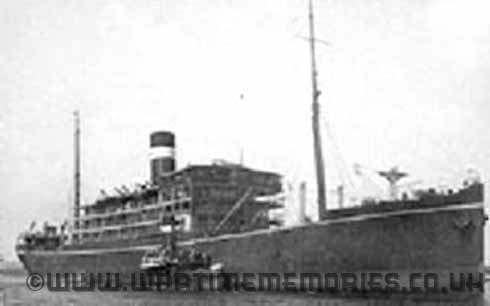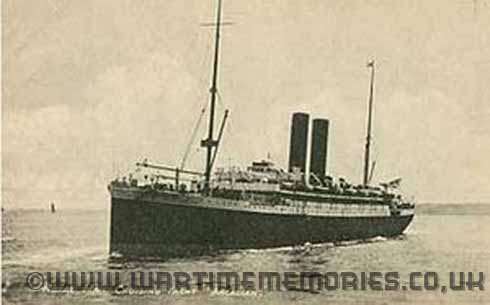|
This website uses cookies. By continuing to use this site you agree to accept cookies. If you enjoy this site please consider making a donation. 
Features Submissions Information World War 1 One ww1 wwII greatwar great 1914 1918 first battalion regiment |
The Wartime Memories Project - The Great War - Day by Day
15th April 1917
On this day:
- Relocations 236th London Brigade Royal Field Artillery report Major W Cooper OC. A236 Battery returned from special leave.
War Diaries- Australian Troop Transports
HMAT A47 Mashobra
The HMAT A47 Mashobra weighed 8,174 tons with an average cruise speed of 12.5 knots or 23.15 kmph. It was owned by the British India SN Co Ltd, London, and leased by the Commonwealth until 21 December 1916. The Mashobra was torpedoed and sunk in the Mediterranean, 15 April 1917.
John Doran- British Troopship
HMT Arcadian
SS Arcadian was a Barrow-in-Furness built passenger liner constructed in 1899 by Vickers, Sons & Maxim Ltd for the Pacific Steam Navigation Company as SS Ortona. During World War I she served with the Royal Navy and was sunk by a U-boat in 1917.
Pacific Steam Navigation Company service, 1899-1906
SS Ortona was the last ship that Pacific Steam built for the London to Australia route. Launched on 10 July 1899 and registered in Liverpool on 26 October, she left London on her maiden voyage was on 24 November in a joint service with the Orient Steam Navigation Company. She carried 140 first class, 180 second class and 300 third class passengers, a total of 620. In December 1902, Ortona was used to return troops to the UK after the end of the Second Boer War.
Royal Mail Steam Packet Company service, 1906-1915.
On 8 May 1906, Ortona was sold to the Royal Mail Steam Packet Company, who used her in a joint operation with the Orient line to Australia. In April 1909, she was transferred to the Royal Mail West Indies service.
In 1910, she was sent to the Harland & Wolff shipyard in Belfast for conversion into a 320-capacity cruise ship with a new gross tonnage of 8,939. She was renamed Arcadian on 21 September 1910 and registered at Belfast in September of the following year. She started her first world cruise in January 1912, the largest dedicated cruise ship in the world at that time. It was on the first leg of this voyage that Olave St Claire Soames met Lieutenant General Sir Robert Baden-Powell, the founder of the Scout Movement, leading to their marriage in October of that year.
In February 1915, near the start of the First World War, Arcadian was taken-up by the Admiralty and converted to an armed merchant cruiser. On 7 April 1915 at Alexandria, General Sir Ian Hamilton came aboard and used Arcadian, together with the battleship Queen Elizabeth, as his headquarters ship during opening phase of the Gallipoli Campaign. Once Hamilton's staff had transferred to a shore base at Imbros, Arcadian was employed as a troop ship in the Mediterranean.
On 15 April 1917 Arcadian was en route from Salonika to Alexandria with a company of 1,335 troops and crew and escorted by a Japanese Navy destroyer. Shortly after completing a boat drill, while 26 miles north east of the Greek island of Milos, Arcadian was hit by a single torpedo from the German submarine UC-74 and sank within six minutes with the loss of 279 lives. A contemporary newspaper article described how four of Arcadian's overcrowded lifeboats were successfully lowered before it sank. Many of the dead were cooks and stokers who were working below decks. The escorting destroyer had two torpedoes launched at her while she was attempting to rescue men from the water; survivors reported that she had lowered three of her own boats while going "at full speed". More survivors, who had been clinging to a raft, were rescued at midnight by the Q-ship, HMS Redbreast. Among the dead was the eminent bacteriologist, Sir Marc Armand Ruffer, who was returning to Alexandria after advising on the control of an epidemic among troops based at Thessaloniki.
John Doran- Bathing and training
- Dismounted Party returns
- Moving Out
- Relieved
- Into the Trenches
- CAUCOURT
15 -19 April. Training at CAUCOURT. The weather mostly very wet and cold.
18th DLI war diary WO95/2361/1- Praise for Battalion Work
- In Action
- Training
- A Quiet Few Days
- In Support
- Shelling
- Reliefs
- Shelling
- Bad Weather
- Training
- Exchange of Fire
- Brigade Paper Chase
- Reliefs
- Bombardment
- In the Line
- In Billets
- German Line Strong
- Bombardment
- Baths
- Reliefs
- Artillery quiet due to incessant rain.
- Parades
- Operation postponed
- 156th Infantry Brigade Operation Order No.7
- Camp shelled with H.E.
- Two Enemy H.E. Shells landed in the Brigade area
- In Front Line
- Battalion Church Parade.
- At Rest
- No Working Parties.
Can you add to this factual information? Do you know the whereabouts of a unit on a particular day? Do you have a copy of an official war diary entry? Details of an an incident? The loss of a ship? A letter, postcard, photo or any other interesting snipts?If your information relates only to an individual, eg. enlistment, award of a medal or death, please use this form: Add a story.
Killed, Wounded, Missing, Prisoner and Patient Reports published this day.
This section is under construction.
Want to know more about 15th of April 1917?
There are:41 items tagged 15th of April 1917 available in our Library
These include information on officers, regimental histories, letters, diary entries, personal accounts and information about actions during the Great War.
Remembering those who died this day, 15th of April 1917.
Pte. Mark Thomas Allen. 2nd Btn. Suffolk Regiment Pte. Cecil William James Bell. Royal Army Medical Corps Read their Story. Pte. Rochus Edward Bevan. 1st/5th Btn. East Kent Regiment Read their Story. 2nd Lt. Henry Whitby Briscoe. 3rd Garrison Btn. Royal Irish Fusiliers Read their Story. Pte. Davidson Ross Burns. 2nd/4th Btn. Duke of Wellington's (West Riding Regiment) Read their Story. Pte. Thomas Charles Chaney. 8th Squadron Machine Gun Corps Read their Story. Rfm. Frederick Thomas Edward Crawford. 16th Btn. London Regiment (Queen's Westminster Rifles) Read their Story. 2/Lt. Eric Charles Freear. 4th Btn Bedfordshire Regiment Read their Story. 2nd.Lt. Eric Charles Freear. 4th Btn. Bedfordshire Regiment Read their Story. Pte. James Holder Grimes. 18th (2nd South East Lancashire) Btn. Lancashire Fusiliers Read their Story. Pte. William Buntin Henderson. 2nd Btn. Black Watch (Royal Highlanders) Read their Story. Pte. William Buntin Henderson. 2nd Btn. Black Watch (Royal Highlanders) Read their Story. Pte. Philip Hurson. 24th (Tyneside Irish) Battalion Northumberland Fusiliers Read their Story. Pte. Joseph Collis Lee. 18th Btn. Lancashire Fusiliers Read their Story. A/Sgt. Frederick John Lowe. Royal Field Artillery Pte. William Lugg. 1st Battalion Dorsetshire Regiment Pte. Joseph Parker. 1st Btn. East Lancashire Regiment Read their Story. Pte. Albert Patchett. 1/4th Battalion Royal Scots Fusiliers Read their Story. Pte. Thomas Greville Peacock. 2/7th Btn. West Yorkshire Regiment Read their Story. Lt. Charles Pope. VC. 11th Battalion Lt. Charles Pope. VC. 11th Btn. Read their Story. L/Cpl. Robert Price. K Supply Coy. Army Service Corps Read their Story. Pte. A Redford. 20th Battalion Read their Story. Lt Gerald Mercer Renny. 92nd Brigade Read their Story. Pte. Ellis Smith. 11th Btn. Border Regiment Read their Story. Pte. Alfred George Spurling. 1st Battalion East Kent Regiment Read their Story. Pte. Herbert Stirman. 1st Btn. Devonshire Regiment Read their Story. Pte. Robert Swindlehurst. 1st Btn. East Lancashire Regiment Read their Story. L/Cpl. Joseph Young. 4th Btn. South Wales Borderers Read their Story. Add a name to this list.
Select another Date
The free section of The Wartime Memories Project is run by volunteers.
This website is paid for out of our own pockets, library subscriptions and from donations made by visitors. The popularity of the site means that it is far exceeding available resources and we currently have a huge backlog of submissions.
If you are enjoying the site, please consider making a donation, however small to help with the costs of keeping the site running.
Hosted by:
Copyright MCMXCIX - MMXXV
- All Rights Reserved -We do not permit the use of any content from this website for the training of LLMs or for use in Generative AI, it also may not be scraped for the purpose of creating other websites, books, magazines or any other forms of media.


